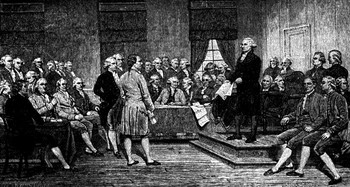Part 4: The Presidency Now that the Congress was taken care of, the delegates moved on to the chief executive, the President. Alexander Hamilton, a delegate from New York, proposed that the President be elected by the people but serve as President for the rest of his life. This idea was very unpopular with the other delegates, many of whom had just fought in a war against a tyrant king.
The result was another compromise. This one created the Electoral College. It sounds like a complicated idea, but it's really very simple. Here's how it works:
Another power given to the President was the veto. The President could veto, or reject, any bill passed by Congress. If this happened, Congress would have to approve the bill by a two-thirds margin for it to become a law. The President was also given the power to appoint federal judges, who served for life. Next page > The New National Government > Page 1, 2, 3, 4, 5, 6 |
|
Social Studies for Kids
copyright 2002–2025
David White

 The
delegates finally agreed that the President would serve a
four-year term. But how would he be elected? Some delegates
thought that the same voters who selected the members of the
House of Representatives should select the President. Most
of the delegates, however, disagreed. They thought that
people who were educated and knew a lot about government and
politics should select the President.
The
delegates finally agreed that the President would serve a
four-year term. But how would he be elected? Some delegates
thought that the same voters who selected the members of the
House of Representatives should select the President. Most
of the delegates, however, disagreed. They thought that
people who were educated and knew a lot about government and
politics should select the President.

